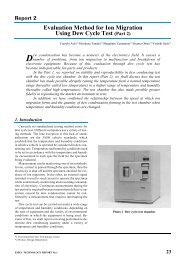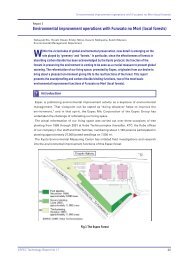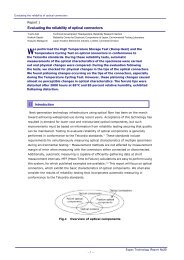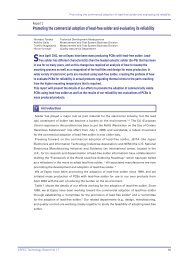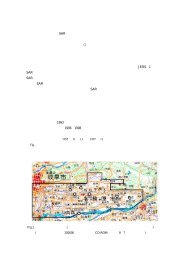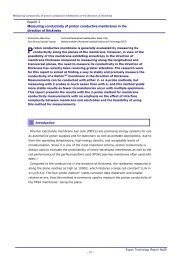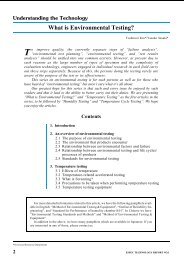download
download
download
Create successful ePaper yourself
Turn your PDF publications into a flip-book with our unique Google optimized e-Paper software.
Measuring Conductivity of Proton Conductive Membrane in the direction of thickness, partⅡ:<br />
using the 4-probe method in the direction of thickness<br />
Table 2 Effects of hot-pressing conditions and electrode material<br />
on MEA measuring performance<br />
Hot-pressing temperature<br />
/ pressure<br />
Forming method<br />
/ electrode material<br />
One-step<br />
Two-step*<br />
Teflon-Pt<br />
Varnish-Pt<br />
Polyester-Cu<br />
150℃ 80℃<br />
40 kgf cm -2 200 kgf cm -2 400 kgf cm -2 40 kgf cm -2 200 kgf cm -2 400 kgf cm -2<br />
Stretched<br />
coating<br />
Unstable<br />
performance<br />
Poor<br />
performance<br />
Wire break,<br />
Stretched<br />
coating<br />
- 10 -<br />
Wire break,<br />
Stretched<br />
coating<br />
Wire break Wire break<br />
Poor<br />
performance<br />
Wire break<br />
Teflon-Pt - - -<br />
Varnish-Pt - - -<br />
Polyester-Cu - - -<br />
Stretched<br />
coating<br />
Unstable<br />
performance<br />
Good<br />
performance<br />
Stretched<br />
coating<br />
Good<br />
performance<br />
Excellent<br />
performance<br />
Wire break,<br />
Stretched<br />
coating<br />
Wire break,<br />
Stretched<br />
coating<br />
Wire break Wire break<br />
Poor<br />
performance<br />
Stretched<br />
coating<br />
Unstable<br />
performance<br />
Good<br />
performance<br />
Poor<br />
performance<br />
Wire break,<br />
Stretched<br />
coating<br />
Poor<br />
performance<br />
Unstable<br />
performance<br />
*:Reference electrode wires were previously imbedded into electric current lead-in membranes<br />
by hot-pressing at 150℃ and 400 kgf cm -2 for 1 min in the first step<br />
The one-step method in MEA manufacturing refers to a technique in which the MEA specimen is<br />
completed using a single hot-pressing process with the laminate stack sandwiched by two electric<br />
current lead-in membranes, two reference electrode wires, and one test membrane. Using the<br />
one-step method, shown in Table 2, MEA specimens prepared at relatively lower temperature or<br />
pressure afforded a comparatively higher measuring performance for all three reference<br />
electrode materials used, more obviously in the case of Cu/polyester coated wire. On the other<br />
hand, measuring performance of the MEA specimens was enhanced dramatically with the<br />
two-step method, which features a preceding hot-pressing process by which the reference<br />
electrode was imbedded into the electric current lead-in membranes. The results exhibited the<br />
marked effectiveness of the two-step method over the one-step method. Moreover, Table 2 also<br />
reveals an increase in the measuring performance of the MEA specimens with the use of<br />
electrode material in the following order: Pt/Teflon, Pt/varnish, and Cu/polyester.<br />
Microscope analysis was used to clarify the mechanism of failure of the MEA specimens,<br />
observing and analyzing reference electrodes that underwent hot-pressing treatments. Typical<br />
failure examples of reference electrodes are shown in Photo 1. These failures occurred after first<br />
undergoing a hot-pressing process in the first step when using the two-step method.<br />
Espec Technology Report No.23



